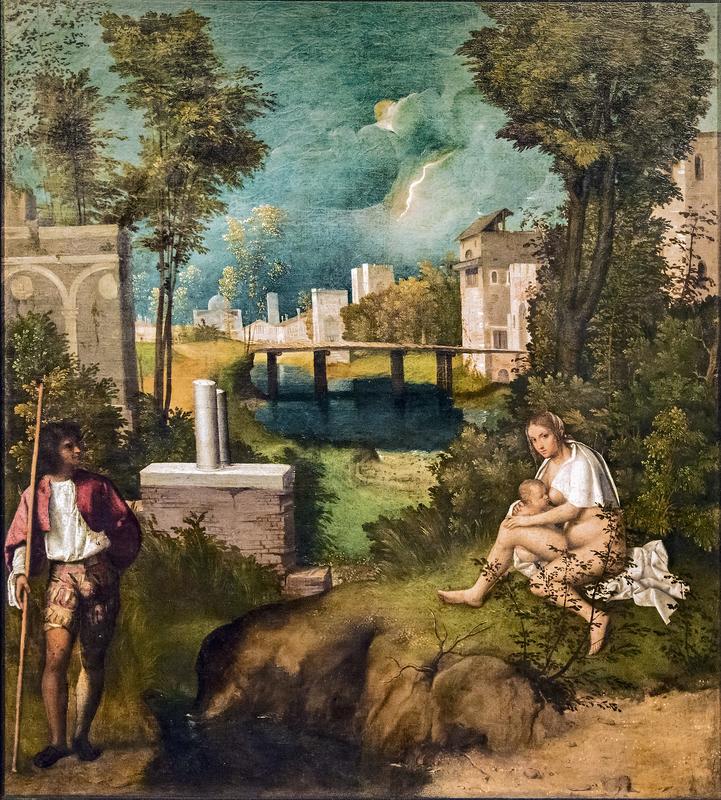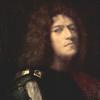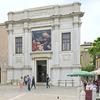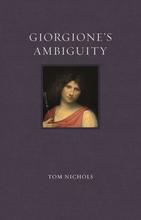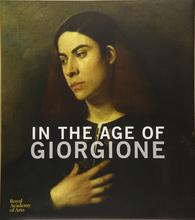More about The Tempest
- All
- Info
- Shop
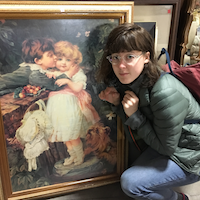
Contributor
Giorgione liked to paint obscure subject matter that no one understands today, like The Tempest.
Of course, the most perplexing detail is why exactly one fully clothed person and one nude person would be picnicking in the middle of an apparent thunderstorm (re: lightning striking in the distance), but more on that later.
Giorgione completed The Tempest in 1508, just two years before he died from the plague, and it’s one of only six works that are attributed to him for certain. At least three of those six pieces have extremely ambiguous subject matter, making it nearly impossible to determine what they are supposed to mean. The reason why Giorgione’s work evades interpretation is that his style of painting is drastically different than the detailed religious art that came before him.
He took cues from Leonardo da Vinci, using many thin layers of paint to produce a gauzy atmosphere that Art Historians call sfumato. His approach was revolutionary; this was the first time that someone was creating paintings that praised ambiance over easily interpretable (religious) symbolism, and it catalyzed a new style of painting in Venice known as the Venetian Renaissance.
Although it’s advanced in technique, The Tempest’s composition is very bizarre. The woman is almost completely nude except for a white shawl that wraps around her shoulders and under her bottom. She’s breastfeeding a baby yet holding it in a very awkward position, off to the side so that her pubic area is exposed. Honestly though, everything is overshadowed by the serious side-eye she’s giving out as she stares directly at the viewer. The male (dressed in a very festive getup) and female characters don’t seem to fit, but that’s probably because they weren’t originally intended to be together. X-ray scans have revealed that Giorgione originally painted a second nude female figure where he later placed the man.
Scholars have made many assumptions as to what exactly is happening in this painting, but still, no one agrees. Some interpretations claim that the couple represents:
- Adam and Eve
- A specific Greek Myth
- A gypsy woman and a soldier or shepherd
- Venice and its defender
Others have decided to throw all of this out the window to conclude that the painting has no subject. It’s entirely possible that Giorgione chose these figures merely because they look good in the composition and not because of some larger meaning. It could be, quite possibly, nothing more than the greatest prank of all time.
Sources
- Brown, Josie. “The Tempest (1503-1508) by Gorgione.” RenaissanceVenice. https://www.renaissancevenice.org/content/essay/tempest-1503-1508-gorgi… (accessed 14 June 2018).
- Settis, Salvatore. Giorgione's Tempest: Interpreting the Hidden Subject. (Cambridge: Polity Press, 1990).
- Zucker, Steven and Harris, Beth. "Giorgione, The Tempest." Smarthistory. https://smarthistory.org/giorgione-the-tempest/ (accessed 14 June 2018).
Featured Content
Here is what Wikipedia says about The Tempest (Giorgione)
The Tempest (Italian La Tempesta) is a Renaissance painting by the Italian master Giorgione dated between 1506 and 1508. Originally commissioned by the Venetian noble Gabriele Vendramin, the painting is now in the Gallerie dell'Accademia of Venice, Italy. Despite considerable discussion by art historians, the meaning of the scene remains elusive.
Check out the full Wikipedia article about The Tempest (Giorgione)

